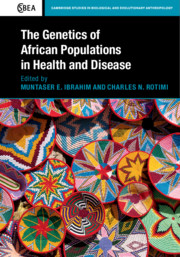Book contents
- The Genetics of African Populations in Health and Disease
- Cambridge Studies in Biological and Evolutionary Anthropology
- The Genetics of African Populations in Health and Disease
- Copyright page
- Contents
- Contributors
- 1 Reflections on Conceptualizing Africa for Biological Studies with a Historical Component
- 2 History and Genetics in Africa
- 3 Disease, Selection, and Evolution in the African Landscape
- 4 Genetic Susceptibility to Visceral Leishmaniasis
- 5 Genetics of Infection in Sub-Saharan Africa
- 6 Pharmacogenomics and Infectious Diseases in Africa
- 7 A Glimpse into Pharmacogenomics in Africa
- 8 Genomics of Cardiometabolic Disorders in Sub-Saharan Africa
- 9 Breast Cancer in African Populations
- 10 Sociobiological Transition and Cancer
- 11 The Genetic Epidemiology of Orphan Diseases in North Africa
- 12 Birth Defects and Genetic Disease in Sub-Saharan Africa
- 13 Neurogenetic Disorders in Africa: Hereditary Spastic Paraplegia
- 14 Enabling Genomic Revolution in Africa
- Index
- References
12 - Birth Defects and Genetic Disease in Sub-Saharan Africa
Published online by Cambridge University Press: 02 December 2019
- The Genetics of African Populations in Health and Disease
- Cambridge Studies in Biological and Evolutionary Anthropology
- The Genetics of African Populations in Health and Disease
- Copyright page
- Contents
- Contributors
- 1 Reflections on Conceptualizing Africa for Biological Studies with a Historical Component
- 2 History and Genetics in Africa
- 3 Disease, Selection, and Evolution in the African Landscape
- 4 Genetic Susceptibility to Visceral Leishmaniasis
- 5 Genetics of Infection in Sub-Saharan Africa
- 6 Pharmacogenomics and Infectious Diseases in Africa
- 7 A Glimpse into Pharmacogenomics in Africa
- 8 Genomics of Cardiometabolic Disorders in Sub-Saharan Africa
- 9 Breast Cancer in African Populations
- 10 Sociobiological Transition and Cancer
- 11 The Genetic Epidemiology of Orphan Diseases in North Africa
- 12 Birth Defects and Genetic Disease in Sub-Saharan Africa
- 13 Neurogenetic Disorders in Africa: Hereditary Spastic Paraplegia
- 14 Enabling Genomic Revolution in Africa
- Index
- References
Summary
A birth defect is defined as any abnormality affecting body structures or function that is present from birth, or may be diagnosed only later in life. Causes can be divided broadly into two groups: genetic and partially genetic causes originating mostly before conception, and causes developing after conception but before birth. In industrialized countries, genetic abnormalities account for about 7 percent of birth defects, mainly numerical or structural chromosomal abnormalities, e.g., Down syndrome or single genes defects, e.g., sickle cell anemia. Partial genetic birth defects are due to a combination of genes that puts the fetus at risk in the presence of specific environmental factors, and account for an estimated 20–30 percent of all birth defects, a number of which are lethal, e.g., congenital heart disease (Turnpenny and Ellard 2007). Causes of birth defects originating after conception are primarily non-genetic. These include teratogens that interfere with normal growth and development of the embryo or fetus (maternal illness, maternal infections, drugs, radiation, and environmental pollutants), mechanical forces that deform the fetus, and vascular accidents that disrupt the normal growth of organs. This category accounts for an estimated 5–10 percent of all birth defects (Turnpenny and Ellard 2007). About 50 percent of birth defects are of unknown cause. These types of defects may be due to new mutations, submicroscopic chromosome deletions, or epigenetic modification. With ongoing advances in genomic technology, including affordable individual whole-genome sequencing, analysis of copy number variants, methylation, and genome-wide association studies, the underlying causes of more birth defects will become apparent (Butler 2009; Lupski et al. 2010; Stefansson et al. 2008; Vissers et al. 2009).
- Type
- Chapter
- Information
- The Genetics of African Populations in Health and Disease , pp. 268 - 310Publisher: Cambridge University PressPrint publication year: 2019
References
- 3
- Cited by

